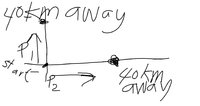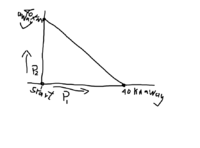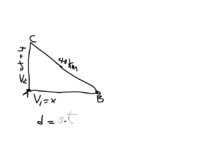You are using an out of date browser. It may not display this or other websites correctly.
You should upgrade or use an alternative browser.
You should upgrade or use an alternative browser.
Find their respective speeds
- Thread starter eddy2017
- Start date
lev888
Elite Member
- Joined
- Jan 16, 2018
- Messages
- 2,940
YesOh, I think I should have drawn two points. One for each car, right?. Because both were at 40 kilos apart.
lev888
Elite Member
- Joined
- Jan 16, 2018
- Messages
- 2,940
Draw itIt looks to me that if I draw a line to join the two points at the 40 kms, a right triangle is formed. Just saying.
D
Deleted member 4993
Guest
And then use Pythagorean theorem (hypotenuse = 40) to calculate and thenDraw it
speed = distance over time to calculate the individual speeds.
eddy2017
Elite Member
- Joined
- Oct 27, 2017
- Messages
- 2,525
I am on it!And then use Pythagorean theorem (hypotenuse = 40) to calculate and then
speed = distance over time to calculate the individual speeds.
Is the formula, right?
s=d/t
Last edited:
lev888
Elite Member
- Joined
- Jan 16, 2018
- Messages
- 2,940
Yes. What's the plan?I am on it!
Is the formula, right?
s=d/t
lev888
Elite Member
- Joined
- Jan 16, 2018
- Messages
- 2,940
Go where? You have the right triangle which gives you a certain relationship that connects its sides. You have d=st. Any ideas?Hey, Khan said: Get the hypothenuse, the hypothenuse is 40, but I know the formula for the hypothenuse, and is not s=d/t .
Do I find the hypothenuse or do I go with the speed formula, what is the best way?.
eddy2017
Elite Member
- Joined
- Oct 27, 2017
- Messages
- 2,525
Alright, thanks. give me some time, please.Go where? You have the right triangle which gives you a certain relationship that connects its sides. You have d=st. Any ideas?
Use the notation to help you.
You know the general formula relating average rate, distance, and time
[MATH]d = r * t.[/MATH]
Subhotosh Khan told you to label the unknowns.
[MATH]d_1 = \text {distance travelled by car 1.}[/MATH]
[MATH]r_1 = \text {average rate of car 1.}[/MATH]
[MATH]t_1 = \text {time traveled by car 1.}[/MATH]
[MATH]d_2= \text {distance travelled by car 2.}[/MATH]
[MATH]r_2 = \text {average rate of car 2.}[/MATH]
[MATH]t_2 = \text {time traveled by car 2.}[/MATH]
[MATH]x = \text {final distance between the cars.}[/MATH]
Are all of those unknown?
No. We know that [MATH]t_1 = 2 \text { and } t_2 = 2.[/MATH]
We also know that x = 40.
So there are four unknowns. That means we need four equations.
[MATH]2r_1 = d_1.[/MATH] Just applying the general rule to the specific case.
[MATH]2r_2 = d_2.[/MATH] Same thing.
And the problem tells you that [MATH]r_1 = r_2 + 4.[/MATH]
All of that should be almost automatic if you name the relevant variables, determine which are unknown, and look for the obvious equations. Now we need to determine the non-obvious equation or equations. We have found three and need four. That last equation is best found using a diagram and seeing that the Pythagorean Theorem applies.
What is that fourth equation? Once you have that, the thinking is over. It’s just manipulation of symbols after that.[/MATH]
You know the general formula relating average rate, distance, and time
[MATH]d = r * t.[/MATH]
Subhotosh Khan told you to label the unknowns.
[MATH]d_1 = \text {distance travelled by car 1.}[/MATH]
[MATH]r_1 = \text {average rate of car 1.}[/MATH]
[MATH]t_1 = \text {time traveled by car 1.}[/MATH]
[MATH]d_2= \text {distance travelled by car 2.}[/MATH]
[MATH]r_2 = \text {average rate of car 2.}[/MATH]
[MATH]t_2 = \text {time traveled by car 2.}[/MATH]
[MATH]x = \text {final distance between the cars.}[/MATH]
Are all of those unknown?
No. We know that [MATH]t_1 = 2 \text { and } t_2 = 2.[/MATH]
We also know that x = 40.
So there are four unknowns. That means we need four equations.
[MATH]2r_1 = d_1.[/MATH] Just applying the general rule to the specific case.
[MATH]2r_2 = d_2.[/MATH] Same thing.
And the problem tells you that [MATH]r_1 = r_2 + 4.[/MATH]
All of that should be almost automatic if you name the relevant variables, determine which are unknown, and look for the obvious equations. Now we need to determine the non-obvious equation or equations. We have found three and need four. That last equation is best found using a diagram and seeing that the Pythagorean Theorem applies.
What is that fourth equation? Once you have that, the thinking is over. It’s just manipulation of symbols after that.[/MATH]
lev888
Elite Member
- Joined
- Jan 16, 2018
- Messages
- 2,940
Look at the triangle. What's the length of the short leg? Can we express it through the known data? Same question for the long leg. You know the hypotenuse. How are these 3 quantities connected?I am stuck here. Don't know what to do next.
eddy2017
Elite Member
- Joined
- Oct 27, 2017
- Messages
- 2,525
Wow!. Well, I have to take my time, guys. I take my hat off to you all. Wow!. Ill get back to you. I'll have dinner now. Thanks a lot. I will rest a bit after dinner, reflect on what you have told me and be back early tomorrow again. Merry Christmas.
eddy2017
Elite Member
- Joined
- Oct 27, 2017
- Messages
- 2,525
Thanks,Use the notation to help you.
You know the general formula relating average rate, distance, and time
[MATH]d = r * t.[/MATH]
Subhotosh Khan told you to label the unknowns.
[MATH]d_1 = \text {distance travelled by car 1.}[/MATH]
[MATH]r_1 = \text {average rate of car 1.}[/MATH]
[MATH]t_1 = \text {time traveled by car 1.}[/MATH]
[MATH]d_2= \text {distance travelled by car 2.}[/MATH]
[MATH]r_2 = \text {average rate of car 2.}[/MATH]
[MATH]t_2 = \text {time traveled by car 2.}[/MATH]
[MATH]x = \text {final distance between the cars.}[/MATH]
Are all of those unknown?
No. We know that [MATH]t_1 = 2 \text { and } t_2 = 2.[/MATH]
We also know that x = 40.
So there are four unknowns. That means we need four equations.
[MATH]2r_1 = d_1.[/MATH] Just applying the general rule to the specific case.
[MATH]2r_2 = d_2.[/MATH] Same thing.
And the problem tells you that [MATH]r_1 = r_2 + 4.[/MATH]
All of that should be almost automatic if you name the relevant variables, determine which are unknown, and look for the obvious equations. Now we need to determine the non-obvious equation or equations. We have found three and need four. That last equation is best found using a diagram and seeing that the Pythagorean Theorem applies.
What is that fourth equation? Once you have that, the thinking is over. It’s just manipulation of symbols after that.[/MATH]
I am writing it out on paper.
I have a question.
Why do you say that
t1=2
and
t2=2
How do we know that?.
.
Last edited:



